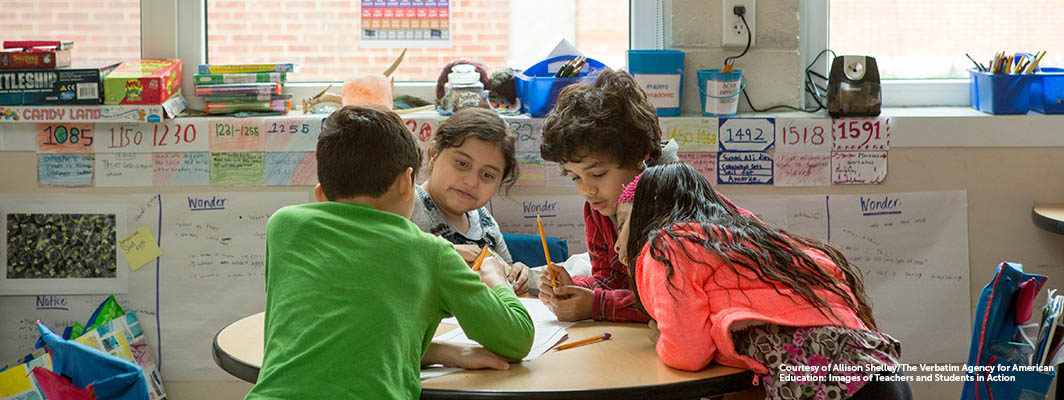This article originally appeared on Usable Knowledge from the Harvard Graduate School of Education. Read the original version here.
In recent years, education leaders have hailed curriculum choice as a low-cost way to improve student success. But in the first multi-state effort to measure textbook efficacy since the implementation of the Common Core, researchers at the Center for Education Policy Research (CEPR) at Harvard University saw no difference in the average fourth- and fifth-grade math achievement gains of schools using different elementary math textbooks. At current levels of curriculum usage and professional development, textbook choice alone does not seem to improve student achievement.
To estimate school-level differences in student achievement growth, the research team — led by Thomas Kane, a professor at the Harvard Graduate School of Education, and David Blazar, an assistant professor at the University of Maryland — used data on student achievement and math textbook adoptions in fourth- and fifth-grade classrooms in six states (California, Louisiana, Maryland, New Jersey, New Mexico, and Washington) from three school years (2014–15 through 2016–17). They also surveyed teachers on their use of textbooks and supplemental materials, as well as the availability and use of professional development related to math instruction and curriculum. The study sample included almost 6,000 schools and over 1,200 teachers across the six states.
Among the key findings — of interest to district leaders, curriculum specialists, and school-based educators:
- Contrary to prior studies, this analysis finds little evidence of differences in average math achievement growth in schools using different elementary math curricula. Although the researchers saw substantial variation in achievement growth among the schools using each particular curriculum, there were no differences in average student achievement growth between curricula. The findings were similar for specific subgroups of students, such as English language learners, students eligible for free or reduced-price lunch, and students with high- or low-baseline achievement. Nor was the variation in textbook effectiveness any different in the subset of schools in which teachers reported the highest average levels of textbook usage, or in schools that had been using the text for two or more years.
- The vast majority of teachers used their school’s official curriculum in more than half their lessons, but few used it exclusively. Ninety-four percent of teachers reported using the official curriculum in more than half of their lessons for some purpose, such as creating tasks or activities for class, selecting examples to present, or assigning problems for independent practice or homework. Just 21 percent of teachers use the textbook in nearly all their lessons for all essential activities, including in-class exercises, practice problems, and homework problems. Only 6 percent of teachers reported that they used their textbook exclusively.
“It may be a mistake to think of curriculum choice and teaching reforms as alternative ways of improving student outcomes. Rather, to gain the benefits of either, districts may need to do both.” — Thomas Kane
- The elementary math textbook market is concentrated, but market share for specific texts varies by state. Roughly 70 percent of elementary schools in the six states used one of seven texts, and 90 percent used one of 15 texts (out of 44 textbooks observed in this study). For instance, in New Mexico, the market was nearly evenly split among three textbook series — enVision, My Math, and Stepping Stones — all of which were written for or adapted to the Common Core. Comparatively, in Louisiana almost 60 percent of schools used Engage NY/Eureka, an open source curriculum also written for the Common Core.
- Time spent in professional development varied by curriculum but was generally low. Teachers using Engage NY/Eureka reported receiving the most professional development tailored to the curriculum, but it was still modest: two days, on average, compared to one day or fewer, on average, for teachers using other textbooks. Additionally, 51 percent of teachers using Engage NY/Eureka reported working with a math coach, compared to roughly 35 percent of teachers using other textbooks.
- The research on textbook efficacy is sparse. Of the 44 textbooks observed in the study sample, only five have been evaluated in a manner meeting the highest evidence standards of the federal What Works Clearinghouse, while only three of these are among the top fifteen most commonly used textbooks in our sample.
“Some leaders may see the adoption of a new curriculum as an ‘easy, inexpensive and quick’ alternative to more controversial, expensive, or time-consuming policies such as teacher evaluation or classroom coaching,” says Kane. “It may be a mistake to think of curriculum choice and teaching reforms as alternative ways of improving student outcomes. Rather, to gain the benefits of either, districts may need to do both.”
This article originally appeared on Usable Knowledge from the Harvard Graduate School of Education. Read the original version here.

